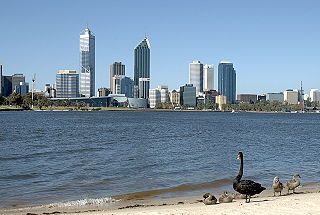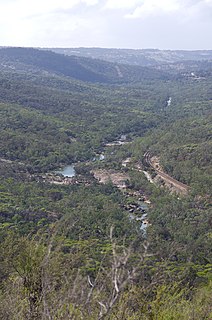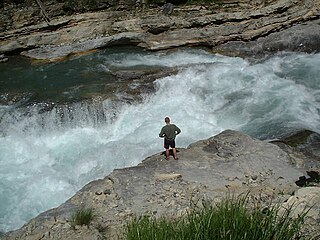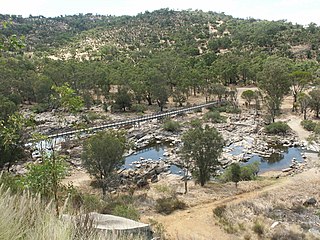Related Research Articles

The Swan River is a river in the south west of Western Australia. Its Noongar Aboriginal name is the Derbarl Yerrigan. The river runs through the metropolitan area of Perth, Western Australia's capital and largest city.

The Avon River is a river in Western Australia. A tributary of the Swan River, the Avon flows 240 kilometres (150 mi) from source to mouth, with a catchment area of 125,000 square kilometres (48,000 sq mi).

Whitewater forms in a rapid context, in particular, when a river's gradient changes enough to generate so much turbulence that air is trapped within the water. This forms an unstable current that froths, making the water appear opaque and white.

The River Wye is the fourth-longest river in the UK, stretching some 250 kilometres from its source on Plynlimon in mid Wales to the Severn estuary. For much of its length the river forms part of the border between England and Wales. The Wye Valley is designated an Area of Outstanding Natural Beauty. The Wye is important for nature conservation and recreation, but is severely impacted by pollution.

Northam is a town in the Australian state of Western Australia, situated at the confluence of the Avon and Mortlock Rivers, about 97 kilometres (60 mi) east-northeast of Perth in the Avon Valley. At the 2016 census, Northam had a population of 6,548. Northam is the largest town in the Avon region. It is also the largest inland town in the state not founded on mining.
Boat racing is a sport in which boats, or other types of watercraft, race on water. Boat racing powered by oars is recorded as having occurred in ancient Egypt, and it is likely that people have engaged in races involving boats and other water-borne craft for as long as such watercraft have existed.

Toodyay, known as Newcastle between 1860 and 1910, is a town on the Avon River in the Wheatbelt region of Western Australia, 85 kilometres (53 mi) north-east of Perth on Ballardong Noongar land. The first European settlement occurred in the area in 1836. After flooding in the 1850s, the townsite was moved to its current location in the 1860s. It is connected by railway and road to Perth. During the 1860s, it was home to bushranger Moondyne Joe.

Canoe slalom is a competitive sport with the aim to navigate a decked canoe or kayak through a course of hanging downstream or upstream gates on river rapids in the fastest time possible. It is one of the two kayak and canoeing disciplines at the Summer Olympics, and is referred to by the International Olympic Committee (IOC) as Canoe/Kayak Slalom. The other Olympic canoeing discipline is canoe sprint. Wildwater canoeing is a non-Olympic paddlesport.

Great Eastern Highway is a 590-kilometre-long (370 mi) road that links the Western Australian capital of Perth with the city of Kalgoorlie. A key route for road vehicles accessing the eastern Wheatbelt and the Goldfields, it is the western portion of the main road link between Perth and the eastern states of Australia. The highway forms the majority of National Highway 94, although the alignment through the Perth suburbs of Guildford and Midland, and the eastern section between Coolgardie and Kalgoorlie are not included. Various segments form parts of other road routes, including National Route 1, Alternative National Route 94, and State Route 51.

Lee Valley White Water Centre is a white-water slalom centre, that was constructed to host the canoe slalom events of the London 2012 Olympic Games. On 9 December 2010, Anne, Princess Royal officially opened the venue which is owned and managed by Lee Valley Regional Park Authority. The £31 million project to construct the centre finished on schedule and was the first newly constructed Olympic venue to be completed.

Brigadoon is a suburb of Perth, Western Australia. It is in the City of Swan local government area.
The Massive Murray Paddle, formerly the Red Cross Murray Marathon or Murray Marathon, and later the YMCA Massive Murray Paddle, is an Australian 404 km, 5-day canoe/kayak flatwater race on the Murray River. One of the longest annual flatwater canoe races in the world, it starts in Yarrawonga and ends in Swan Hill. The race raises funds to assist local community-driven programs.
The Hawkesbury Canoe Classic is an annual marathon canoe race taking place on the Hawkesbury River in Northwest Sydney usually at the end of October. The Hawkesbury Canoe Classic consists of a 111 km paddle downstream starting in Windsor and finishing in Mooney Mooney. The race is Australia's fourth-longest annual canoe race after the 404 km Murray Marathon, the 208 km Riverland Paddling Marathon on the Murray River between Martins Bend and Morgan in South Australia and the 133 km Avon Descent in Western Australia. The Hawkesbury Canoe Classic has over 600 paddlers each year. Around 600 paddlers travel 111 km in moonlight, down the Hawkesbury River from Windsor to Brooklyn, to raise money for Charity. Over the years the Hawkesbury Classic has developed into a great event. Paddlers, their land crew and hundreds of volunteers converge on the banks of the Hawkesbury River at Windsor on the day of the event to enjoy the fun and competition of an overnight paddle, and the now famous camaraderie and spirit of the event. Paddlers leave Windsor between 4pm and 6pm on Saturday and pass 20 safety checkpoints during the night. The fastest craft arrive at Brooklyn on Sunday morning in less than 10 hours, but the average time is closer to 15 hours. The classic began in 1977 and is made possible by volunteers who put in hundreds of hours of time throughout the year, the landowners who allow the use of their land for the weekend and the paddlers and their support crews. The Classic has raised more than $3.3 million for medical research, the major beneficiary continues to be will be the Arrow, The Bone Marrow Transplant Foundation. The 2018 classic will be held on 27–28 October 2018.

Bayswater is a suburb 6 km (4 mi) north-east of the central business district (CBD) of Perth, the capital of Western Australia. It is just north of the Swan River, within the City of Bayswater local government area. It is predominantly a low-density residential suburb consisting of single-family detached homes. However, there are several clusters of commercial buildings, most notably in the suburb's town centre, around the intersection of Whatley Crescent and King William Street and a light industrial area in the suburb's east.

Clackline is a locality in the Wheatbelt region of Western Australia, about 80 kilometres (50 mi) east-north-east of Perth.

Canoe marathon is a paddling sport in which athletes paddle a kayak or canoe over a long distance to the finish line. While the International Canoe Federation states the standard distances are up to 30 km, many races are significantly longer. Many events are raced down sections of river, including currents or portages around obstacles. Some events attract thousands of competitors and are staged over several days.

The following outline is provided as an overview of canoeing and kayaking:

The Umkhomazi River is a river in KwaZulu-Natal, South Africa.

The Prague Canoeing Centre is one of the most frequently used venues for international canoe slalom competition. Built in 1983 in Czechoslovakia, it diverts water around a 3.6 metres (12 ft) dam at Troja on the Vltava river in Prague. Its two unique features are its use of car and truck tires as flow diverters and its shallow slope, closer to 1% than the usual nearly 2% for such venues. Despite these characteristics, the Troja facility has hosted ten World Cup races and one World Championship in the 21 years 1992–2012, and the 2013 World Championships.
References
- ↑ "AVON RIVER RAGE PROMISES TO BE A LEADING W.A. AQUATIC ATTRACTION". The Beverley Times . 68 (27). Western Australia. 2 August 1973. p. 1. Retrieved 29 June 2017– via National Library of Australia.
- ↑ https://www.avondescent.com.au/about/history/ Official website - with a very brief history of the original event
- ↑ "Avon descent to be filmed". The Beverley Times . 69 (20). Western Australia. 6 June 1974. p. 1. Retrieved 28 August 2021– via National Library of Australia.
- ↑ Tone'o (2018), Avon Descent 2018 WA , retrieved 28 August 2021
- ↑ Northam's Avon Descent Association (1980), Northam's Avon Descent, Northam's Avon Descent Association, retrieved 29 June 2017
- ↑ 2002 special
- ↑ "About the Avon Descent". Avon Descent. Archived from the original on 26 February 2014. Retrieved 9 August 2014.
- ↑ in 1994 -Bolland, Terry; BOLLAND, Terry (1994), Canoeing down under! : the basics and beyond and Avon River guide, T. Bolland, ISBN 978-0-646-10075-3
- ↑ and another edition in 2001 Bolland, Terry (2001), Canoeing down under : the basics and beyond & Avon River guide (Rev. ed.), Terry Bolland, ISBN 978-0-646-10075-3
- ↑ Western Australia. Department of Land Administration. Cartographic Services Branch (1990), The Avon Valley (1st ed.), Cartographic Services Branch, Department of Land Administration, retrieved 28 August 2021
- ↑ https://www.avondescent.com.au/about/overview/ Overview page on website has a map from which the places have been identified
- ↑ Northam and Districts Historical Society, The Bridges of Northam : Bypass and Katrine Drive , retrieved 28 August 2021
- ↑ https://www.avondescent.com.au/about/overview/ Map overview